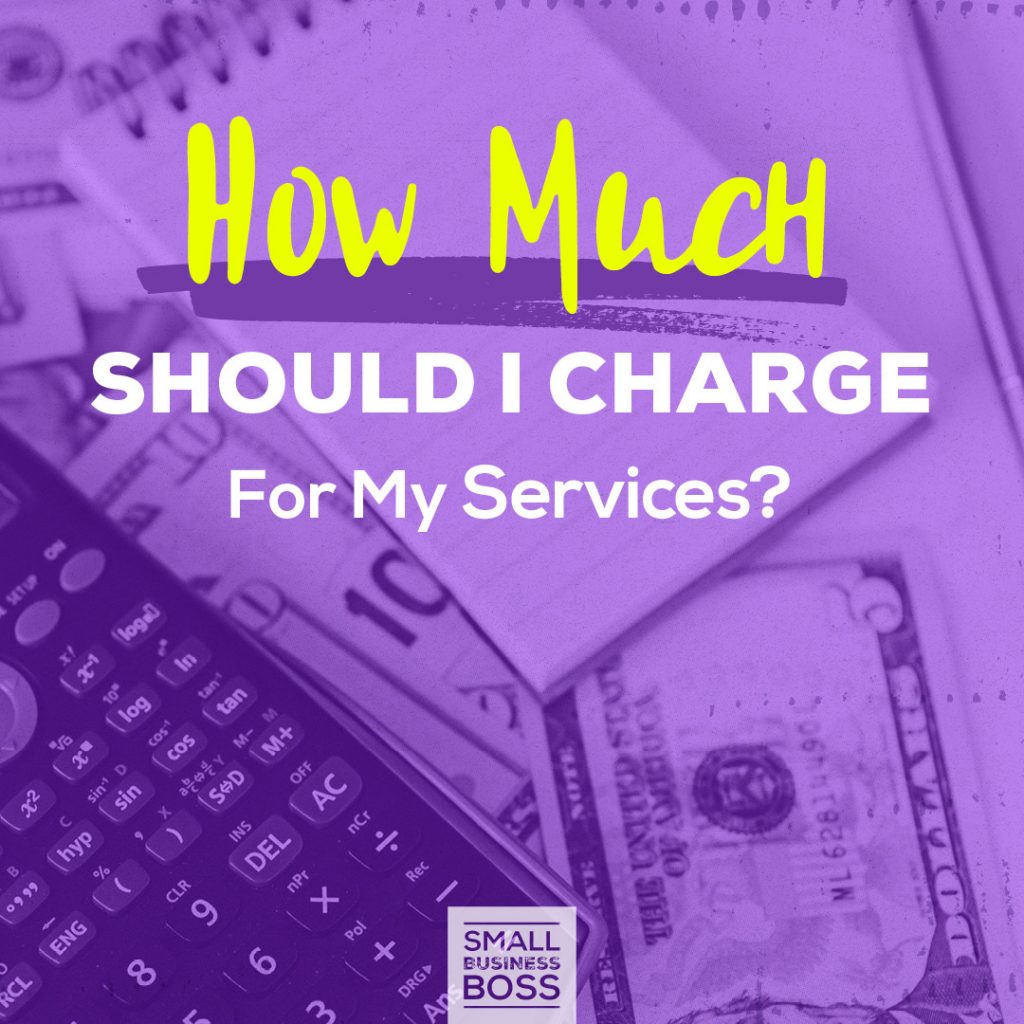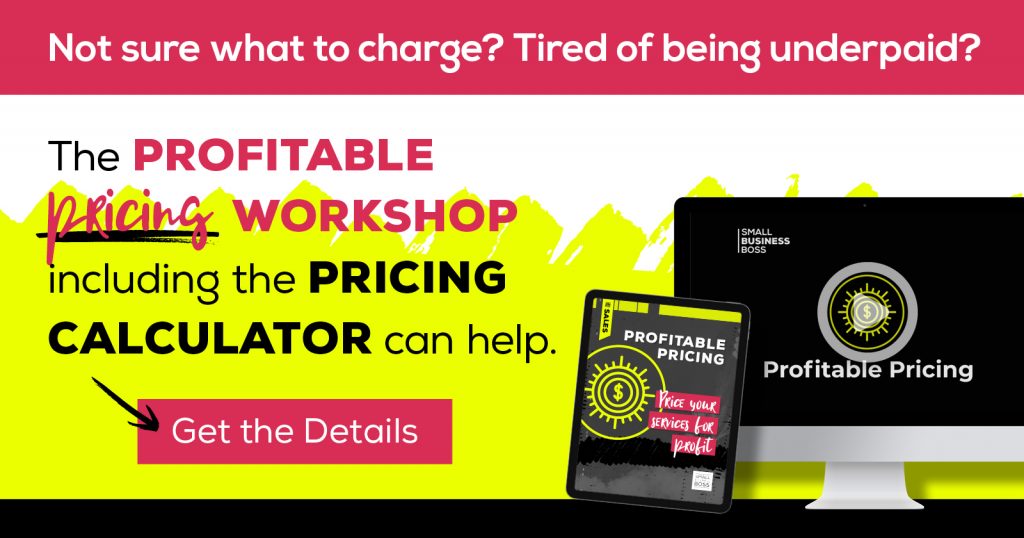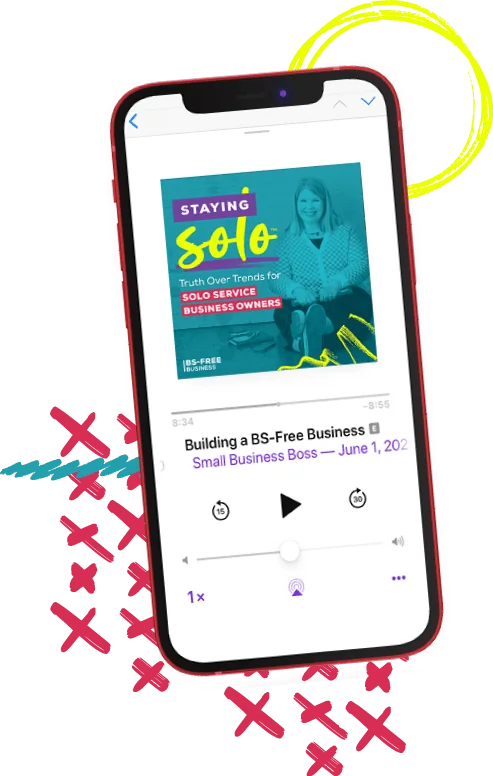
Search the site:
How Much Should I Charge For My Services?
If I had to pick one question that comes up most often when working with clients in our masterminds, it’s probably, “how much should I be charging services?”
I get it. There’s no easy answer, even for the most experienced service providers. Deciding on the right price for your potential customers can be tricky.
You’re trying to figure out how to be profitable and build a sustainable business model while also grappling with the stories you have going on in your head about money. As if that’s not challenging enough, you’re also running into everything from clichéd pricing tips to downright crappy pricing advice everywhere you look online.
But your service pricing strategy and the question of charging for services impacts everything in your business. It determines how much you’ll be able to pay yourself, and your profit margins.
The Impact of Your Pricing
Pricing is about more than getting paid. It impacts how you position and sell your offers as well as how you operate your business.
A great example is when you’re looking to hire a team member. How you price your services impacts your ability to pay that person in a way that’s not exploitative. If you’re not charging for services at a high enough baseline hourly rate, you’re stuck with either having to underpay someone or not hiring at all.
That’s just one of countless examples, and why it’s so important not to dismiss pricing as only being about your ability to pay yourself.
Another common issue that I see is how chronically underpricing takes its toll as you’re overworked and become resentful and seriously stressed out. On the flip side, when you’re charging for services at TOO high of an hourly rate, you may find it hard to actually sell your services or be stuck with clients that have unrealistic expectations thanks to the high price tag.
The reality is that pricing issues are at the root of many of the biggest problems service-based businesses face.
Creating a sustainable value-based pricing strategy requires an understanding of the nuances of pricing.
So, if you’re looking for an answer to the question, ‘how much should I be charging for services?’ In short, it’s complicated.
There’s no easy answer when it comes to knowing what to charge, first let’s take a look at what not to do. Then we’ll dive into what it takes to build a pricing strategy that works.
Common Pricing Mistakes
Whether you’re just getting started or you’ve been in the game for a while, pricing mistakes can be costly. Getting it right will take some trial and error and, as with anything related to business, you’ll always be learning.
It helps to know what mistakes to avoid along the way.
#1. Trying to Replace Your Salary
I see this a lot, especially when freelancers, creatives and consultants are first starting out. They work for an employer providing a service like copywriting or web design or develop a skill as a side hustle. Then, when they strike out on their own, they charge clients some fraction of their former salary, dividing it by a 40-hour week to come up with an hourly rate.
The thinking here is that if you can replace your income by working for yourself on your terms, you’ll be happy. This approach ignores your total employment compensation cost, including taxes, benefits, paid time off and more, as well as the indirect costs of doing business — most significantly, not all your time working will be billable hours. (Trust me, there are always hours per week that will simply not be billable no matter how hard you may try, even if you’re using a project rate!)
#2. Winging It
Not knowing what else to do, you might find yourself taking a wild guess and throwing a price out there to see what sticks.
During my first year in business, I chose a number that seemed reasonable and went with it. Because I came from the agency world, I had a pretty good idea of what other services professionals were charging, so it worked for me. But here’s the problem — I stuck with that same price for eight years, selling myself seriously short over time and not charging for services at a high enough rate
If you’re not privy to any insider information on the going rates for your services in your industry, chances are you have no idea what a reasonable price even is. You can easily end up with a rate that’s too low or even too high, both of which are tough to sustain.
Even with experience under your belt, winging your pricing means you haven’t determined what it costs you to deliver each service. Your pricing needs to account for how much time is involved, hard costs such as fees for tools and subcontractor rates and indirect costs such as time invested into sales, marketing and operations.
Check out Profitable Pricing which includes a pricing calculator to help you nail down your pricing.

#3. Bargain Basement Pricing
Undercharging is rampant among service-based business owners. Some of this has to do with not fully understanding the value your services deliver or the hard costs of delivering those services.
You might think that presenting yourself as an affordable option makes clients more likely to choose you or that discounting your services will bring you more business. The reality is, low pricing can actually work against you in more ways than one when it comes to charging for services.
Competing on pricing is a race to the bottom; someone will always be willing to offer a cheaper option. Clients looking for rock-bottom pricing are likely to treat you poorly, push your boundaries and diminish your expertise. Frankly, cheap clients that care most about the price can be an absolute nightmare.
The other issue is that if you charge too little, clients seeking high-quality services will simply assume you don’t measure up. It makes you seem inexperienced and too good to be true; otherwise, you’d be in demand and charging accordingly.
Your pricing tells a story, and when you go too low, it tells one that attracts the wrong kind of clients.
#4. Charging What You’re Worth
At first blush, this sounds like great advice — the anecdote to low pricing. I suspect that’s why it’s repeated so often. Many people mean well when they say to charge what you’re worth and it’s meant to be encouraging and empowering.
Frankly, it’s a load of crap.
How are we supposed to know what we’re worth? What if your parents, society, and the voices in your head tell you you’re not worth much of anything at all? Or what if all of the above inflated your ego, making you think that a mediocre effort is worth more than the market is willing to pay?
Every single one of us is worth a hell of a lot more than whatever we charge for our services. The last thing you want to do is tie your self-worth up in your business revenue.
In short, “charge what you’re worth” is worthless advice. It doesn’t give you anything to aim for, not even a ballpark, so it can lead to second-guessing yourself and waffling in your pricing.
Don’t get caught up in the head trash of it, and instead focus on developing a practical pricing strategy that works for you.
#5. Overblown Premium Pricing
When mentoring service-based business owners, my one of my biggest challenges used to be convincing them to raise their rates. These days, I find myself talking people down from the BS promises and exploitive practices of the online luxury coaching high-ticket offer obsession.
Don’t get me wrong. If you’re talented at what you do, delight your clients and work with established companies with healthy budgets, you can charge a premium.
To command top-shelf prices and sustain them over time, you have to be willing to do what it takes to:
- Tap into a real need that you’re uniquely positioned to fulfill.
- Put in the work to build your brand authority as a “category of one”.
- Ensure clients are happy with your services and will enthusiastically hire you again or refer you.
In the online business world, undercharging is rampant, but so is overcharging and underdelivering. How people are charging for services spans a huge range.
If this is news to you, check out my 2021 Online Business Investment Survey where people used words like bamboozled, cheated, infuriated, gutted, scammed and swindled to describe their experience with being sold a bill of goods wrapped in premium pricing.
If you sell a truly premium, high-quality service but people keep telling you that you’re too expensive, you probably need to work on your branding and messaging.
And if you’re consistently getting undercut and losing out on business, it could also be time to lower your prices and reassess some other aspect of your service delivery.
Now that you know some of the mistakes to avoid when pricing your services, let’s look at what it takes to develop a pricing strategy that works.
Developing Your Pricing Strategy: ‘How much should I charge for my services?’
If you’re asking the question, ‘how much should I charge for my services?’ it can be frustrating to learn there’s no easy answer. But that doesn’t mean there isn’t an answer that’s right for your specific business.
Remember, although you may be offering a similar service as your competitor, no two businesses are alike. You bring a different set of skills, background, experience and track record to the table.
It’s important to remember that you aren’t pricing in a void. When making decisions about charging for services, you should know where you sit in the marketplace as a point of reference by answering the following:
- What are your competitors charging? For what, exactly?
- Can you back up the results you promise?
- What makes you different? How do you stand out?
Profitable and sustainable pricing comes down to three core things:
- Demand for the service you offer.
- Perception of you, your business and what you’re offering.
- The value your service actually brings and the results you deliver.
Not only that but what you can charge isn’t necessarily what you should charge. You’ll want to factor in your personal goals and desires as much as anything else.
Consider these questions:
- How much do you want to work?
- How much are you willing to invest in your training, tools, branding and team?
- Do you want to offer the kind of high-touch access a premium paying client may demand?
Finding the sweet spot for your pricing often requires testing, experimenting and making adjustments over time.
Remember, what you charge now doesn’t have to be what you charge in six months; nothing is set in stone.
Overall, knowing what you should charge for your services comes down to understanding the real market value of what you offer, being able to communicate it confidently and considering what it will take to truly deliver on your promises.
Are you looking to nail down your pricing strategy so you can charge more for your services without freaking out?
Check out Profitable Pricing in the Small Business Boss Shop for creating a practical pricing strategy that gets you paid as a pro. It includes a pricing calculator to help you do the math along with resources to help your price in a way that gets you paid.


I’m Maggie Patterson (she/her), and services businesses are my business.
I have 20+ years of experience with client services, am a consultant for agency owners, creatives, and consultants, and vocal advocate for humane business practices rooted in empathy, respect, and trust.
Read or Listen to the Latest
For Solo Business Owners

Growing a solo service business is tough.
It’s even harder when you’re bombarded with BS advice that steers you away from your values and why you started your business in the first place.
This is the podcast for solo creatives and consultants who want to remain as a team of one and have zero interest in the hustle and grind of typical business teachings.
Subscribe now and never miss an episode.
For Micro Agency Owners
Most podcasts for agency owners obsess over revenue growth as the ultimate success metric.

But here’s the truth: not everyone wants to make millions. Your goal might be to build a sustainable business that lets you have a life and doesn’t run you into the ground.
Join me as I spill my shameless confessions and share everything I’ve learned about building a micro agency that skips the BS of tired and typical agency teachings.
Follow Now on All Major Podcast Platforms








